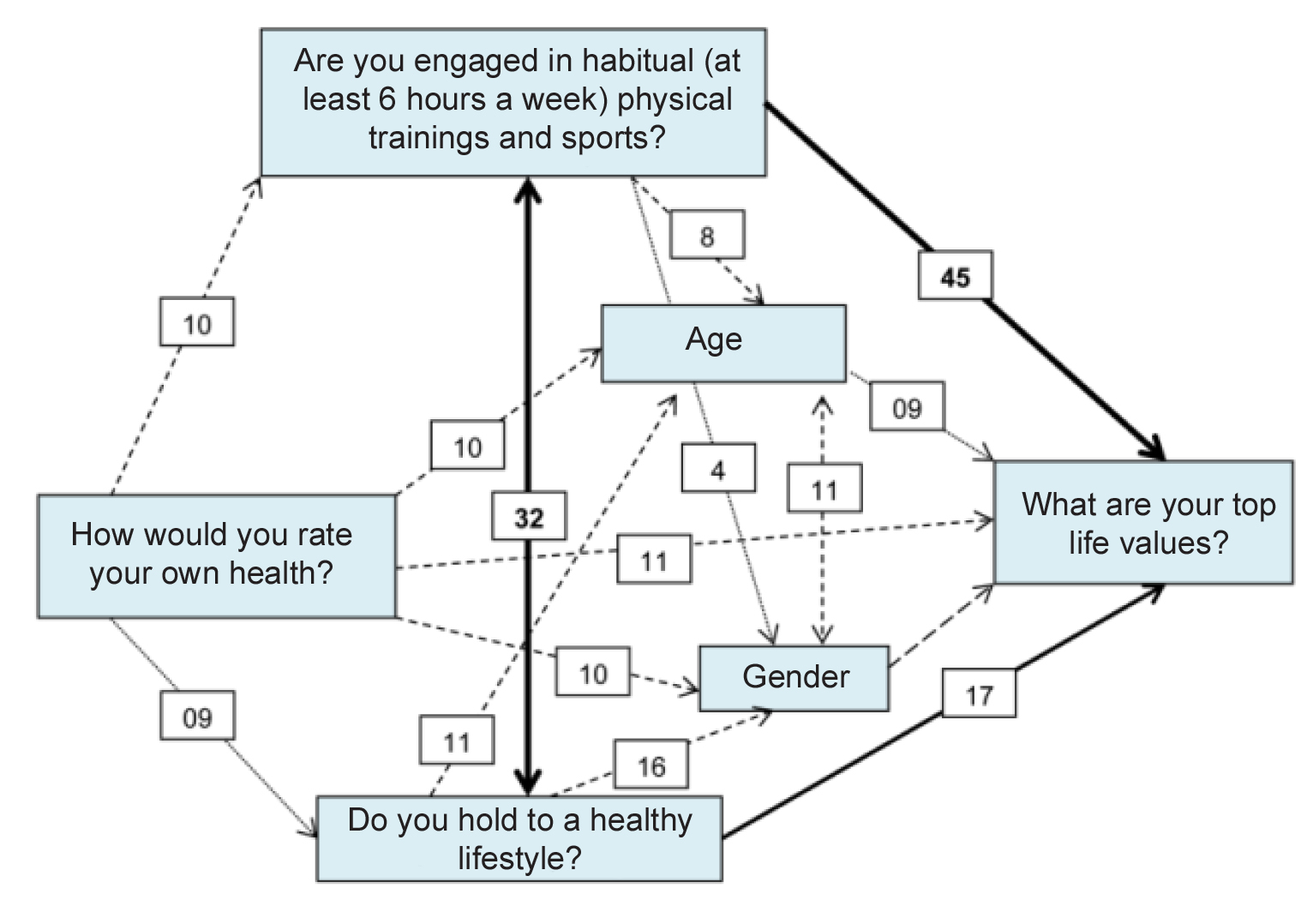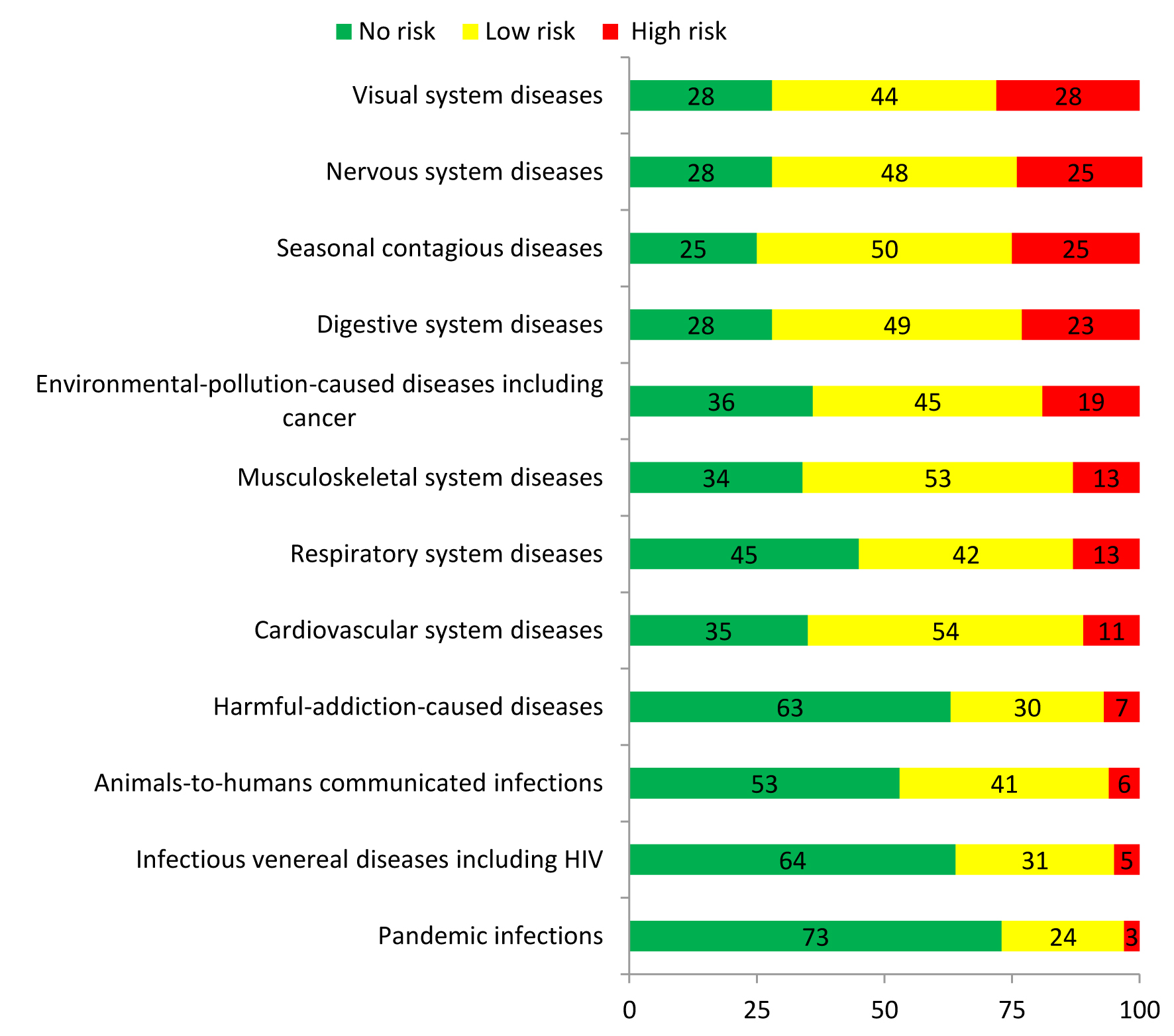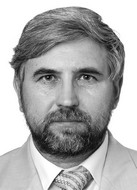Healthy lifestyle among priorities of Middle-Urals urban youth in context of social security
Фотографии:
ˑ:
PhD D.Y. Narkhov1
Dr.Sc.Phil., Professor Y.R. Vishnevskiy 1
PhD, Associate Professor I.M. Dobrynin1
PhD, Associate Professor E.N. Narkhova1
1Ural Federal University (UrFU), Yekaterinburg
Keywords: physical education, healthy lifestyle, youth, students, diseases, social security.
Background. Young people’s health has recently been in top priority for the national youth policy makers, with the notion of ‘healthy lifestyle’ being increasingly flavoured by the relevant political meanings in the youth policies. The national government presently ranks the “healthy lifestyle focused values, physical development provisions for young people… and the life security culture promotion in young population” among its top priorities [7]. The new resourceful public health policies are based on the growing appreciation of the axiological value of the young people’s health ranked among the strategic national resources [2, pp. 123; 11]. Physical and wellness cultures are viewed both as preconditions and mechanisms for the self-protective behavioural models being formed including healthy lifestyles (HLS).
One of the most popular health concepts in sociology was offered by L.M. Drobizheva who defined health as the “integrated index of biological, socio-cultural and economic processes in communities” [5, p. 35]. The derivative notion of HLS may be defined, in the anthropocentric terms, as the lifestyle models and methods designed to strengthen and improve the “bodily adaptive and reserve capacities”; and in the socio-centric terms as facilitating “due social and professional functionality” [1, p. 68].
It is the modern socio-cultural approach that gives a wide context for analysis of the above notions. L.N. Kohan in his classification of cultural system offered a “physical wellness culture” subsystem [6, p. 37] albeit the notion has never been accepted in the social practices. It is paradoxical that the most popular interpretation of the notion of physical culture implies HLS rather than actually includes it [12, p. 322]; and, as a result the popular public health management concepts are not inclusive and consistent enough. This holds true for the youth health management concepts considering youth as a special age group active in every social domain albeit practically managed by the “seven cooks spoiling the broth” – as one can see from an analysis of the relevant valid regulatory documents and schedules produced by the Russian Federal Agency for Youth Matters, Ministry of Sports and other relevant government agencies, each of them holding to its own interpretation of HLS and related matters and, hence, operating with different sets of criteria [3, 9, 11].
Objective of the study was to analyse variations in the young peoples’ behavioural models and lifestyles by a sociological questionnaire survey.
Methods and structure of the study. Subject to the study was the 14-30 year old urban population (n=934) of the Sverdlovsk region estimated to total 861 thousand as of 2015 (including 15% of rural youth). A questionnaire survey under the study performed in April to October 2016 was designed in an electronic opinion poll format to rate the Sverdlovsk regional youth security (SPYS) and health aspects. The sample was broken down by the eager and residence groups and was 45% male, 52% female and 3% sexually indefinite. Social statuses of the respondents were the following: 3% students of secondary vocational education establishments; 33% university students including 23% bachelor course students; 41% office personnel including 38% holding higher education certificates; 7% management officers; 9% labourers; and 7% others including 2.5% housemaids and 1.5% unemployed people.
In addition, we made a detailed analysis of the following two prior questionnaire surveys: (1) Ural Federal University students’ (n=600) survey to find their attitudes to the academic Physical Education discipline in September-October 2015, with the a breakdown by the core university disciplines; and (2) Sverdlovsk regional population (n=1286) survey to find their attitudes to the physical training and sports services in November-December 2016, with the cluster samples by settlements, for the Young Population subgroup.
Study results and discussion. For the last few decades, ‘health’ has always been ranked among the top two terminal values by the young population together with ‘family and children’. Our survey data showed 75% of the SPYS sample ranking health among top-twelve values (in the optional opinion poll offering up to three options). Other values were ranked as follows: 30% money, material assets, own business; 26% good job; and 15% freedom, independence. The instrumental values related to the personal security showed a similar breakdown as follows: 60% opted for ‘being clever, strong, healthy and having due security knowledge and skills’ (out of 10 options); 47% opted for the ‘dependable, trustworthy surrounding (family, neighbours, friends and partners); and 35% opted for the ‘highly secure home, good security tools and wellness to afford high-quality security’.
The respondents reported to generally appreciate the self-protective agenda and healthy lifestyle: thus 2% reported holding to a healthy lifestyle; one of five (20%) said ‘rather not’; and 55% and 23% said ‘yes’ and ‘rather so than not’. In the self-rating of the degree of engagement in physical trainings and sports, 40% reported training at least 6 hours a week. This data was found in good correlation with the physical training and sporting service rating data: thus four respondents out of five believed that the young population of the Sverdlovsk region is well served for health practices; only one of nine said that such services are available only for a handful of special ones; and 7% stated that the services are insufficient. The respondents rated their own health quite optimistically, with half of the sample rating it ‘good’; 12% ‘excellent’; and only 3% ‘poor’ that may mean that some of the respondents have faced health problems; albeit these data still need to be verified versus the local health service reports.
Given on Figure 1 hereunder is the correlation model that shows the degrees and vectors of links of the above health survey rates. The data show that the gap (found back in early 2010) between the reported and actual HLS has even grown up for the time period – as verified, among other things, by the weak one-way correlation (CrV=0.11) between the terminal values cluster and actual HLS.

Figure 1. Correlation model showing the degrees and vectors of links between the terminal age- and gender-specific health values including physical culture and sports, health self-rates, actual and reported HLS, with Cramer values (CrV) [0..1]*100, and with week correlation threshold of 0.2 for the HLS
The sample’s rates of the actual health-protection services for the young population of the Sverdlovsk region were contradictory enough, with half of the sample rating them insufficient; 23% rating them sufficient; and 27% saying that the health service is available only for a handful of special ones.
The respondents’ rates of major disease risks were contradictory too: see Figure 2. The survey data give some indication of the actual health problems albeit the data are in fact inconsistent with the actual disease rates of the young regional population reported by the local health service system as of 2014 [11, pp. 245-269]. Particularly underestimated by the respondents were the cardiovascular, respiratory and musculoskeletal system disorders and diseases versus the formal reported health data – that apparently shows the wellness culture of the local young population being still low. The situation is clearly not irreversible at present as most of the above diseases can be prevented by the relevant physical culture and sporting practices, and the more habitual are the practices the more determined and positive are the trainees (Figure 1, CrV=0.45).

Figure 2. Self-rates of the major health risks, in % of the sample (SPYS)
One more set of the HLS-related questions was designed to detail the young people’s preferred practices within their reported healthy lifestyles. The ranges of practices were found quite different across the sampled youth groups. The study data confirmed the drastic sag in physical activity in the sensitive periods of transition from school to university and from university to job [9, p. 78], with the physical education lessons reported as the dominating form of physical activity in these periods (41% of the sample reported it as a single available form of physical activity). After studies, the only reported form of physical activity is self-trainings. The study found a new trend in the modern academic environments: since the bachelor - master training system was implemented, the above transitional period shifted to the third year. The master training system, for instance, does not have physical education in the academic curriculum in fact; albeit the surveyed masters predominantly welcome this discipline in the curriculum [5] to continue their systemic physical education.
Conclusion. The valid youth-disease-prevention system needs to be upgraded to prevent the prevailing high-risk diseases. An academic physical education discipline is highly recommended both as a legitimate part of the modern curriculum and an efficient tool to develop the modern wellness culture in young people both in the bachelor and master training periods.
References
- Baronenko V.A., Rapoport L.A Zdorovye i fizicheskaya kultura studenta [Student's health and physical culture]. 2nd ed. Moscow: INFRA-M publ., 2012, 336 p.
- Belova O.R., Boronina L.N., Vishnevskiy Y.R. et al. Valeologicheskaya i fizicheskaya kultura: teoretiko-metodologicheskiy analiz [Valeological and physical culture: theoretical and methodological analysis]. Izvestiya Uralskogo federalnogo universiteta. Ser. 1: Problemy obrazovaniya, nauki i kultury, 2013, vol. 113, no. 2, pp. 123-131.
- Biserov V.V., Rukina I.V., Mukhtarova T.L. et al. Fizicheskaya kultura. Ucheb. posobie [Physical education. Study guide]. Yekaterinburg: USTU-UPI publ., 2008, 275 p.
- Dobrynin I.M., Narkhov D.Y., Narkhova E.N. et al. Fizicheskaya kultura kak uchebnaya distsiplina i obraz zhizni v predstavleniyakh sovremennykh studentov [Physical Education as academic discipline and way of life according to modern students]. Vestnik Nizhegorodskogo un-ta im. N.I. Lobachevskogo. Ser. Sotsialnye nauki, 2016, no. 2, pp. 159-167.
- Drobizheva L.M. Tsennosti zdorovya i kultura nezdorovya v Rossii [Health values and bad health culture in Russia]. Bezopasnost Evrazii, 2004, no. 1, pp. 33-43.
- Kogan L.N. Teoriya kultury [Culture Theory]. Yekaterinburg: USU publ., 1993, 160 p.
- Osnovy gosudarstvennoy molodezhnoy politiki Rossiyskoy Federatsii na period do 2025 goda. Utverzhdeny rasporyazheniem Pravitelstva Rossiyskoy Federatsii ot 29 noyabrya 2014 g. no. 2403-r. [Fundamentals of the state youth policy of the Russian Federation for the period until 2025. Approved by the order of the Government of the Russian Federation dated November 29, 2014 no. 2403-r.]. Available at: https://fadm.gov.ru/documents/download/25/ (date of access: 02.09.2017).
- Vishnevskiy Y.R. Otnoshenie zhiteley Sverdlovskoy oblasti k fizicheskoy kulture i sportu: itogi sotsiologicheskogo monitoringa [Attitude of Sverdlovsk region residents to physical culture and sports: results of sociological monitoring]. Yekaterinburg: UU publ., 2013, 324 p.
- Plan meropriyatiy Federalnogo agentstva po delam molodezhi v sfere realizatsii gosudarstvennoy molodezhnoy politiki na territorii Rossiyskoy Federatsii na 2017 god [Action plan of the Federal Agency for Youth Affairs in the sphere of implementation of the state youth policy on the territory of the Russian Federation for 2017]. Available at: https://fadm.gov.ru/activity/scope/7/details (date of access: 10.05.2017).
- Vishnevskiy Y.R. Polozhenie molodezhi Sverdlovskoy oblasti v 2014 godu: nauchnye osnovy doklada pravitelstvu Sverdlovskoy oblasti [Situation with youth in the Sverdlovsk region in 2014: scientific basis of the report to the government of the Sverdlovsk region]. Yekaterinburg: EMC-PI publ., 2016, 350 p.
- Strategiya razvitiya fizicheskoy kultury i sporta v Rossiyskoy Federatsii na period do 2020 goda. Utverzhdena rasporyazheniem Pravitelstva Rossiyskoy Federatsii ot 7 avgusta 2009 goda no. 1101-r. [The strategy of development of physical culture and sports in the Russian Federation for the period until 2020. Approved by the order of the Government of the Russian Federation dated August 7, 2009 no. 1101-r.]. Official Internet portal of legal information. Available at: http://pravo.gov.ru (date of access: 02.07.2017).
- Suslov F.P., Tyshler D.A. Terminologiya sporta: tolkovy slovar sportivnykh terminov (okolo 9500 terminov) [Sports terminology: explanatory dictionary of sports terms (appr. 9,500 terms)]. Moscow: SportAkademPress publ., 2001, 480 p.
Corresponding author: d_narkhov@mail.ru
Abstract
Objective of the study was to analyze variations in the young peoples’ behavioural models and lifestyles that are known to have degraded for the last 25 years to the self-destructive rather than self-protective models, and rate the values-driven behavioural models. The study analyses the sociological aspects and meanings of such notions as ‘healthy lifestyle’ (HLS) and ‘physical culture’ in application to the modern regional youth communities, and the key components of such meanings. The study methods were based on the resource- and risks-focused approaches with the youth viewed as the national strategic resource with its health being pivotal for success of the social development and security policies. Subject to the study was the 14-30 year old urban population of the Sverdlovsk region. A questionnaire survey under the study was designed to rate the degrees of engagement in habitual physical culture, motivations and conditions for and attitudes to the physical education as a subject of curriculum. The survey data were applied to rate the key risks for the personal security and exposure to the prevailing diseases. Based on the study data and analyses, the authors found the gap between the verbal recognition of the self-protection behavioural models and practical values-driven behaviours of the Middle-Urals youth being slowly but persistently bridged.



